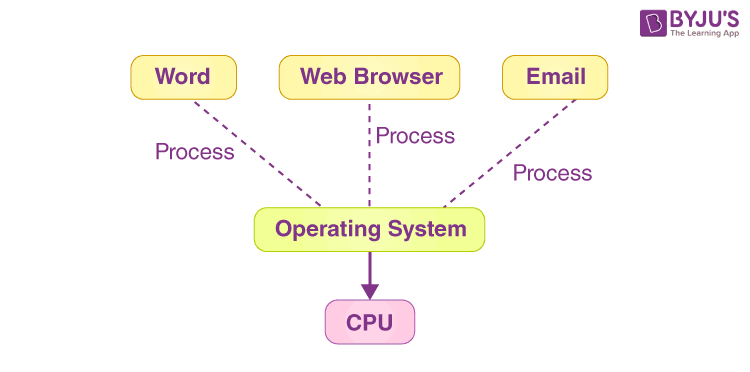The multitasking OS refers to a logical extension of the multiprogramming operating system, which allows users to run many programs simultaneously. It enables a user to complete multiple computer tasks at the same time.
In this article, we will look more into the Multitasking Operating System according to the GATE Syllabus for (Computer Science Engineering) CSE. Let us read ahead to find out more about it.
Table of Contents
- What is the Multitasking Operating System?
- Types of Multitasking OS
- Pros of Multitasking OS
- Cons of Multitasking OS
What is the Multitasking Operating System?
In a modern computer system, the word “multitasking” is employed. It’s a logical extension of the multiprogramming system that allows numerous applications to run simultaneously. Multitasking in an OS enables a user to execute multiple computer tasks at the same time. Processes that hold common processing resources, such as a CPU, are known as many tasks. The operating system remembers where you are in these jobs and lets you switch between them without data being lost.

Although early operating systems could run multiple programs at once, multitasking was not completely supported. As a result, a single piece of software might use the entire CPU of the computer to complete a task. The user was unable to do other operations, such as opening and shutting windows, because basic operating system capabilities, such as file copying, were disabled. Because modern OS provide comprehensive multitasking, multiple programs can run simultaneously without interfering with one another. Furthermore, many OS processes can operate concurrently.
Types of Multitasking OS
Preemptive
Preemptive multitasking is a task that a computer operating system is given. It determines how much time one job spends on the operating system before assigning another process to use it. The operating system is also referred to as ‘preemptive’ because it controls the entire operation.
Desktop operating systems employ proactive multitasking. Unix was the first OS to implement this multitasking technique. The first versions of Windows to implement preemptive multitasking were Windows NT and Windows 95. The Macintosh gained proactive multitasking in OS X. When it’s time for another application to take over the CPU, this operating system instructs the programs.
Cooperative
Cooperative multitasking is referred to as ‘Non-Preemptive Multitasking.’ The basic goal of cooperative multitasking is to complete the current work while allowing another process to execute. taskYIELD is used to complete this task (). Context-switch is called whenever the taskYIELD() function is called.
Cooperative multitasking was utilised by Windows and MacOS. When a Windows program receives a message, it will perform some short unit of work before giving the CPU over to the OS until it receives another message. It operated flawlessly as long as all applications were bug-free and written with other programs in mind.
Pros of Multitasking OS
Manage several users
This OS is more suited to support several users at the same time, and multiple apps can operate smoothly without slowing down the system.
Virtual memory
Multitasking operating systems have the best virtual memory system. Any program does not need a long wait time to perform its tasks because of virtual memory; if this problem arises, then those applications are shifted to virtual memory.
Good reliability
Multitasking operating systems provide multiple users more flexibility, which makes them happier. Besides, each user can run one or more apps at the same time.
Secured memory
Memory management is well-defined in multitasking operating systems. Because of this, the operating system does not grant any permission for unwanted apps to waste RAM.
Time shareable
To avoid having to wait for the CPU, each task is given a specific length of time.
Background processing
Background processes can operate more efficiently under a multitasking operating system. Most users are unaware of these background processes, although they aid the smooth operation of other programs such as antivirus software, firewalls, and others.
Optimise the computer resources
A multitasking OS can manage I/O devices, RAM, hard discs, CPUs, and other computer resources.
Use several programs
Users can run multiple programs at the same time, such as games, an internet browser, Microsoft PowerPoint, Excel, and other utilities.
Cons of Multitasking OS
Processor boundation
Because of the modest pace of its processors, the system may run applications slowly, and their reaction time may increase when processing many programs. More computing power is necessary to solve this challenge.
Memory boundation
The computer’s performance may suffer as a result of many programs running at the same time, as the main memory becomes overcrowded when multiple programs are loaded. Reaction time grows since the CPU is unable to give distinct times for each program. The usage of low-capacity RAM is the primary cause of this problem. As a result, the capacity of the RAM can be increased to meet the requirements.
CPU heat up
In a multitasking environment, numerous processors are busier at the very same time to finish any task; therefore, the CPU generates more heat.
Keep learning and stay tuned to get the latest updates on GATE Exam along with GATE Eligibility Criteria, GATE 2023, GATE Admit Card, GATE Syllabus, GATE Previous Year Question Paper, and more.
Also Explore,
- Batch Operating System
- Binary Semaphores in Operating System
- Contiguous Memory Allocation in Operating System
- Counting Semaphores in Operating System
- Deadlock Detection and Recovery in Operating System
- Deadlock Prevention in Operating System
- Distributed Operating System
- Dynamic Partitioning in Operating System
- Fixed Partitioning in Operating System
- Functions of Operating System
- Methods for Handling Deadlock in Operating System
- Multiprocessing Operating System
- Multiprogramming Operating System
- Network Operating System
- Non-Contiguous Memory Allocation in Operating System
- Operating System Services
- Paging in OS
- Process in Operating System
- Process Scheduler in Operating System
- Process Scheduling in Operating System
- Process State in Operating System
- Real-Time Operating System
- Resource Allocation Graph in Operating System
- Semaphores in Operating System
- Time-Sharing Operating System
- Types of Operating System
Comments